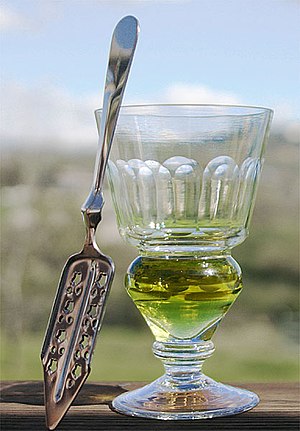 Image via Wikipedia
Image via WikipediaDoes this alcoholic beverage deserve its reputation? Personally I have never tried it; in my younger days I was not into liqueurs, preferring to drink brown and golden brown ales and lagers in my journeys and youthful socialising. But, however, there were plenty around who did, and enjoyed it, it has been widely claimed. And Absinthe does have its very old reputation; does it indeed warrant this? Does it deserve its reputation to make your head swirl after drinking its emerald green contents? Has any alcoholic beverage attracted as much conjecture as Absinthe?
New Zealand is, according to a recent claim, one of the few countries in the world where Absinthe is sold across the counter without any regulation or other restraint. Bartenders here are using it in cocktails and it is also available to take home from most liquor stores as well.
This is apparently remarkable because some brands contain quantities of thujone, a derivative of the leaves and flowers of the wormwood plant from the Mediterranean with a reputation as a 'psychotic convulsant' (described in a number of books and stories over the years) dating back to an earlier time when science and medicines were a great deal different than their modern varieties.
Well do the old reputations stack up today! Will it make you blind and mad, as I have read? There is no evidence to support any assertation or claim that modern Absinthe resembles the rudimentary drink from the past. Recent studies have found small ineffectual doses of thujone may accumulate in the body and produce, over time, minor toxicity. While this might explain Absinthe's alleged reputation for producing a heady buzz, any light- headedness is more likely to be a reaction to over-indulgence of a highly alcoholic beverage that contains a myriad of unfamiliar herbs and flavourings. What a let down! So it was just a case of going on an Absinthe bender? The modern variety perhaps, but like many of the old alcoholic drinks with reputations emanating from the dark and distant past - the Scotch and Irish whiskies for instance - the old Absinthe may well have lived up to its history.
While the modern form of Absinthe has been variously attributed to apothecaries in Switzerland and France, tonics in the manner of Absinthe have existed for thousands of years. Pythagoras and Hippocrates reportedly recommended wormword elixirs for a variety of ailments and were included in medicine chests of doctors in many places for centuries. Even that ubiquitous Vicks VapoRub that many of us have in our own medicine cupboards today, is claimed to contain small quantities of thujone.
Thujone can be reportedly found in other modern alcoholic drinks today, such as Vermouth, Chartreuse and Benedictine. In fact Vermouth, made from using flower heads from Wormword, takes its name from the German' wermuth' . Wormwood is also popular as flavouring for branvin, an alcoholic drink made from potatoes in Sweden.
This is not the end of the wormwood or Absinthe story, just a pause here. I hope you enjoyed the information in my story; I enjoyed researching and writing it. Absinthe, the emerald 'green fairy' may swirl a few more Kiwi heads yet.
![Reblog this post [with Zemanta]](http://img.zemanta.com/reblog_e.png?x-id=2b2bf721-f4bb-4671-8ccc-a72160dfa4e1)
No comments:
Post a Comment